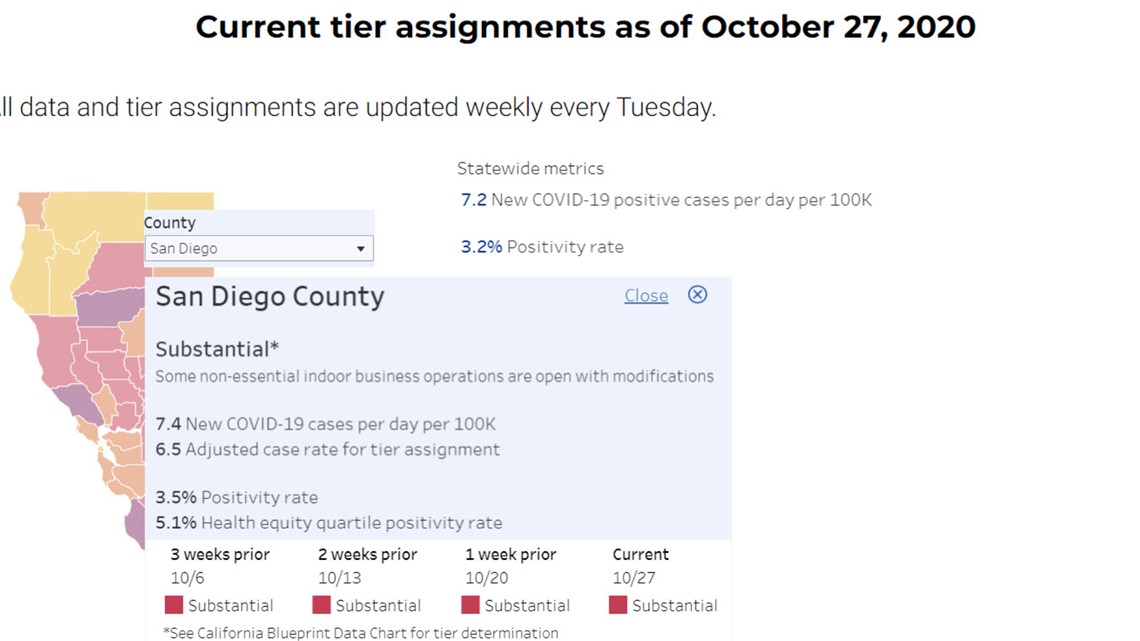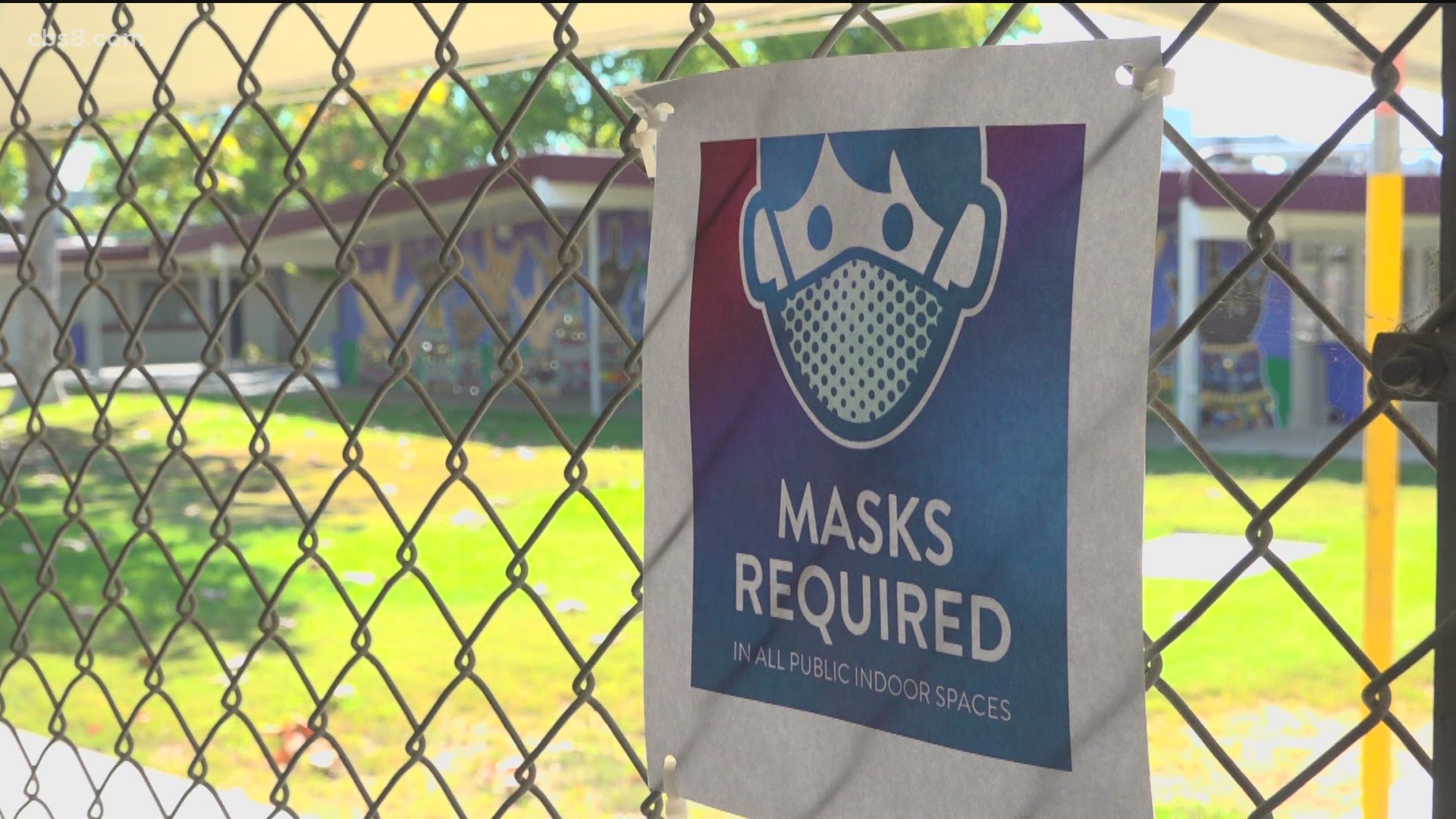SAN DIEGO COUNTY, Calif. — Editor’s note: This story shows updates about the coronavirus outbreak in San Diego and California from Oct. 25 - 27 (afternoon), 2020. Click here for real-time updates for Oct. 27, 2020 and on.
Key COVID-19 facts in San Diego and California:
- There are 54,941 confirmed cases in San Diego County and 870 reported deaths.
- There are 904,198 confirmed cases in California and 17,400 reported deaths.
- View San Diego County cases by zip code or city and find local testing sites.
- Click here for previous updates
Oct. 27
San Diego remains in red tier with 6.5 adjusted case rate
San Diego avoided the possibility of moving to the state's most restrictive purple tier next week and will stay in red tier with 6.5 adjusted case rate, according to data from the state.


Special meeting called by Vista Unified School district over coronavirus concerns
According to the district superintendent, a student tested positive for the virus on Sunday but was said to have been at school on the preceding Tuesday, Wednesday and Thursday.
The superintendent told parents that this is an isolated case where the student likely contracted the virus while traveling on a club athletic team that is not affiliated with the school. This positive test has 150 students and four teachers quarantining. This adds to the numbers of people who are quarantining. A first positive test sent 130 students and staff into quarantine early last week.
For the full story, click here.
Oct. 26
San Diego mom apologizes after kids' COVID diagnosis sends dozens into quarantine
Across San Diego County, hundreds of children under the age of 19 have been diagnosed with COVID-19. Two of them are in Del Mar and their mom is opening up about the immense guilt she said she feels after her kids’ diagnosis sent dozens of their classmates into quarantine.
Molly Chinnock is in quarantine and in pain - but not from COVID-19.
In fact, she's negative for the virus, even after her 10-year-old and 8-year-old tested positive.
San Diego County reports 358 new COVID-19 cases as it awaits state data
San Diego County health officials reported 358 new COVID-19 infections today, bringing the case total to 54,941, including a new case in the Vista Unified School District.
Less than a week after fully reopening its schools, the district reported a second COVID-19 case involving a Mission Vista High School student Monday, leading to the quarantine of about 150 students and four teachers.
Last Tuesday, despite an unadjusted daily COVID-19 case rate of 7.8 per 100,000 population, the county was again able to avoid being pushed into the purple tier of California's four-level reopening system, which would have placed indoor activities at restaurants, movie theaters, gyms and a number of other locations in jeopardy.
Another Mission Vista High School student tests positive for COVID-19
Another student has tested positive for coronavirus at Mission Vista High School, according to Vista Unified School District. Administrators said this is unrelated to a previous case from last week that forced more than 130 students to quarantine.
The school has reached out to the students and teachers who may have been exposed and, they will be in quarantine through next week.
Oct. 25
San Diego County reports 269 new COVID-19 cases; 2 additional deaths
Health officials in San Diego County reported 269 new COVID-19 infections Sunday, bringing the total to 54,583 since mid-February, and two new deaths, bringing the overall fatality total to 870.
The two deaths were men reported to have died earlier this month. They ranged in age from late 60s to early 70s, according to the San Diego County Health and Human Services Agency.
View all News 8 coverage of coronavirus / COVID-19
News 8 has joined forces with The San Diego Foundation to raise immediate, emergency funds for our most vulnerable neighbors in need. Here is how you can help.
BACKGROUND:
On February 11, 2020 the World Health Organization announced an official name for the disease that is causing the 2019 novel coronavirus outbreak, first identified in Wuhan China. The new name of this disease is coronavirus disease 2019, abbreviated as COVID-19. In COVID-19, "CO" stands for "corona," "VI" for "virus," and "D" for disease. Formerly, this disease was referred to as “2019 novel coronavirus” or “2019-nCoV”.
There are many types of human coronaviruses including some that commonly cause mild upper-respiratory tract illnesses. COVID-19 is a new disease, caused by a novel (or new) coronavirus that has not previously been seen in humans.
Currently, there is no vaccine, however, the CDC suggests the following precautions, as with any other respiratory illness:
Know how it spreads:
- The best way to prevent illness is to avoid being exposed to this virus.
- The virus is thought to spread mainly from person-to-person.
- Between people who are in close contact with one another (within about 6 feet).
- Through respiratory droplets produced when an infected person coughs, sneezes or talks.
- These droplets can land in the mouths or noses of people who are nearby or possibly be inhaled into the lungs.
- Some recent studies have suggested that COVID-19 may be spread by people who are not showing symptoms.
Protect yourself and others
Wash your hands often
- Wash your hands often with soap and water for at least 20 seconds especially after you have been in a public place, or after blowing your nose, coughing, or sneezing.
- It’s especially important to wash:
- Before eating or preparing food
- Before touching your face
- After using the restroom
- After leaving a public place
- After blowing your nose, coughing, or sneezing
- After handling your cloth face covering
- After changing a diaper
- After caring for someone sick
- After touching animals or pets
- If soap and water are not readily available, use a hand sanitizer that contains at least 60% alcohol. Cover all surfaces of your hands and rub them together until they feel dry.
- Avoid touching your eyes, nose, and mouth with unwashed hands.
Avoid close contact
- Inside your home: Avoid close contact with people who are sick.
- If possible, maintain 6 feet between the person who is sick and other household members.
- Outside your home: Put 6 feet of distance between yourself and people who don’t live in your household.
- Remember that some people without symptoms may be able to spread virus.
- Stay at least 6 feet (about 2 arms’ length) from other people.
- Keeping distance from others is especially important for people who are at higher risk of getting very sick.
Cover your mouth and nose with a cloth face cover when around others
- You could spread COVID-19 to others even if you do not feel sick.
- The cloth face cover is meant to protect other people in case you are infected.
- Everyone should wear a cloth face cover in public settings and when around people who don’t live in your household, especially when other social distancing measures are difficult to maintain.
- Cloth face coverings should not be placed on young children under age 2, anyone who has trouble breathing, or is unconscious, incapacitated or otherwise unable to remove the mask without assistance.
- Do NOT use a facemask meant for a healthcare worker. Currently, surgical masks and N95 respirators are critical supplies that should be reserved for healthcare workers and other first responders.
- Continue to keep about 6 feet between yourself and others. The cloth face cover is not a substitute for social distancing.
Cover coughs and sneezes
- Always cover your mouth and nose with a tissue when you cough or sneeze or use the inside of your elbow and do not spit.
- Throw used tissues in the trash.
- Immediately wash your hands with soap and water for at least 20 seconds. If soap and water are not readily available, clean your hands with a hand sanitizer that contains at least 60% alcohol.
Clean and disinfect
- Clean AND disinfect frequently touched surfaces daily. This includes tables, doorknobs, light switches, countertops, handles, desks, phones, keyboards, toilets, faucets, and sinks.
- If surfaces are dirty, clean them. Use detergent or soap and water prior to disinfection.
- Then, use a household disinfectant. Most common EPA-registered household disinfectants will work.
Monitor your health daily
- Be alert for symptoms. Watch for fever, cough, shortness of breath, or other symptoms of COVID-19.
- Especially important if you are running essential errands, going into the office or workplace, and in settings where it may be difficult to keep a physical distance of 6 feet.
- Take your temperature if symptoms develop.
- Don’t take your temperature within 30 minutes of exercising or after taking medications that could lower your temperature, like acetaminophen.
- Follow CDC guidance if symptoms develop.
The California Department of Public Health has issued guidance on the use of cloth face coverings to protect against the spread of the novel coronavirus COVID-19.
As of April 4, 2020, all employees in San Diego County who may have contact with the public in any grocery store, pharmacy/drug store, restaurant or food establishments, convenience store or gas station are required to wear a cloth face covering while at work as an additional measure to help “flatten the curve” in the San Diego region.
As of May 1, San Diego County requires everyone in the county to wear face coverings in many public settings. The coverings help prevent the spread of COVID-19 and are part of our path to reopening San Diego. See full health order here.
While officials say these face coverings are not a substitute for practices like social distancing and handwashing, there is evidence to suggest that the use of cloth face coverings by the public during a pandemic could help reduce disease transmission. Officials do not recommend the public use N-95 or surgical masks which are needed by health care workers and first responders.

